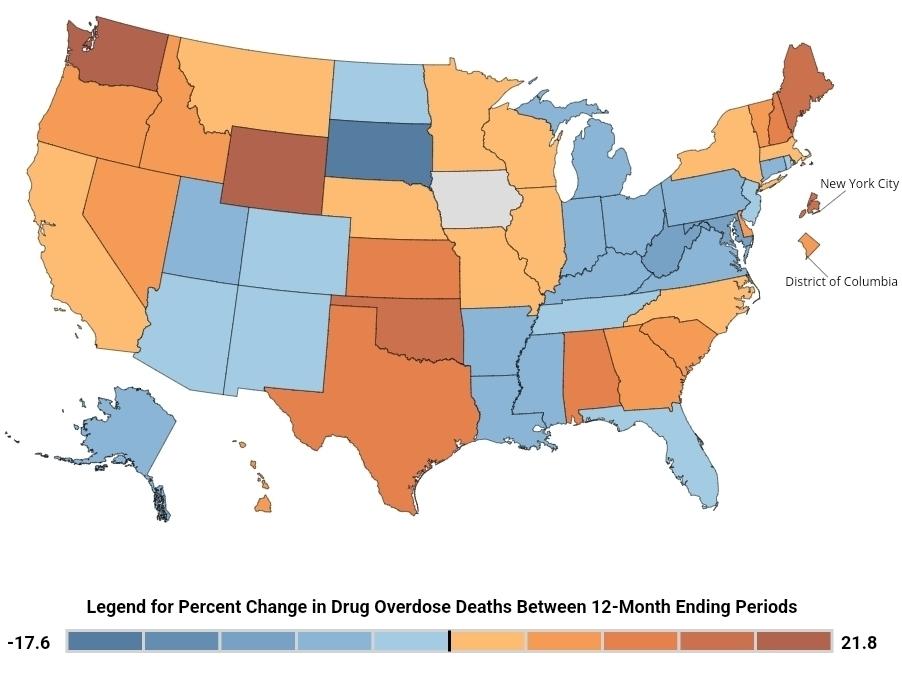Section Branding
Header Content
U.S. drug overdose deaths hit a record in 2022 as some states see a big surge
Primary Content
Drug deaths nationwide hit a new record in 2022. 109,680 people died as the fentanyl crisis continued to deepen, according to preliminary data released by the Centers for Disease Control and Prevention.
Eight states saw drug deaths continue to surge by nine percent or more, with the greatest increases of 21 percent coming in Washington state and Wyoming.
Dr. Nora Volkow, director of the National Institute on Drug Abuse, said it's troubling that deaths continue to rise despite the end of disruptions linked to the COVID pandemic.
"That's a very very high level of overdose deaths," Volkow told NPR.
"One could have expected that as many of the challenges imposed by the COVID pandemic were resolved, we would see a deep dive in the number of overdose deaths. It's concerning we have not seen that."
Some states see improvement
There is some good news in this report. Overdose fatalities rose in 2022 at a much slower rate. Some states hard hit by the opioid-fentanyl epidemic also saw significant declines in drug deaths.
Maryland and West Virginia, two states hit hard by the opioid-fentanyl crisis, each reduced fatalities by roughly 7 percent from 2021 to 2022.
"The fact that it does seem to be flattening out, at least at a national level, is encouraging," Katherine Keyes, a Columbia University epidemiology professor whose research focuses on drug use, told the Associated Press.
"But these numbers are still extraordinarily high. We shouldn't suggest the crisis is in any way over."
The White House described these latest numbers as progress, arguing that by slowing the increase in drug deaths, thousands of lives have been saved nationwide.
"We've expanded treatment to millions of Americans, we're improving access to Naloxone to reverse overdoses, and we're attacking the illicit fentanyl supply chain at every choke point," said Dr. Rahul Gupta, head of the Office of National Drug Control Policy in a statement.
"As a result, around 19,000 people are still alive and can be there at the dinner table, at birthdays, and at life's most important moments."
Speaking with NPR, Gupta said he believes improvements in access to addiction care, implemented over the last two years, will continue to gain traction.
But he acknowledged only 1 in 10 Americans experiencing addiction currently get medical treatment.
Texas, Washington saw big rise in drug deaths
In real numbers, Texas and Washington state saw the biggest increases in drug fatalities in 2022. Both states suffered roughly 500 additional deaths linked to overdose.
"We need to look closely at these states. What are some of the things that are working and not working," said Regina LaBelle, former acting director of the White House Office of National Drug Control Policy, now head of the Addiction and Public Policy Initiative at Georgetown University.
LaBelle also warned drug deaths could begin to surge again nationally because of the toxic street drug supply and other factors.
"One year does not make a trend. Is it leveling off? We need to hope that," LaBelle said, noting that past celebrations of progress during the opioid crisis have been premature.
Indeed, some experts believe the opioid crisis will soon emerge as the gravest public health crisis facing the U.S.
By way of comparison, the CDC says roughly 245,000 people in the U.S. died in 2022 from COVID-19. But effects of the COVID pandemic appear to be fading. As of this month, the virus is no longer considered a national health emergency.
A major study from the medical journal the Lancet last year predicted opioid-fentanyl drug deaths will remain high, claiming another 1.2 million lives in the U.S. by the end of this decade.
"I am not particularly optimistic for the future," said Jonathan Caulkins, an addiction policy researcher at Carnegie Mellon University.
"We have multiple millions of people with opioid use disorder and that's not something you can simply make go away. We are as a country in for bad times for years to come."
Dr. Volkow, head of NIDA, suggested major policy changes could begin to reduce opioid-fentanyl deaths, but she acknowledged progress has been slow.
Decades after the opioid crisis began, the U.S. still lacks real-time data about overdoses and drug deaths, making it difficult to target the public health response effectively.
"I am basing my estimate on drug overdose deaths on data that is basically six months old. So what is happening right now? I don't know. You need timely data, otherwise you're [responding to this crisis] with your eyes closed," Volkow said.
Copyright 2023 NPR. To see more, visit https://www.npr.org.
Bottom Content


